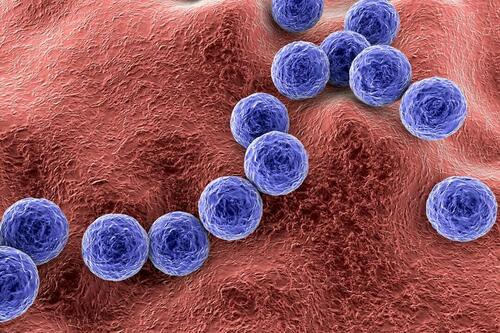
Scientists Develop New Compound That Kills Flesh-Eating And Other Drug-Resistant Bacteria
Authored by Marina Zhang via The Epoch Times (emphasis ours),
Twenty years ago, professor Fredrik Almqvist, an organic chemistry professor at Umeå University in Sweden, was asked by his collaborating researchers at Washington University in St. Louis (WashU) to design a compound that would prevent urinary tract infections, which are often caused by Gram-negative bacterial infections.
 (Kateryna Kon/Shutterstock)
(Kateryna Kon/Shutterstock)Almqvist’s team created various compounds that were then screened for their effects.
Rather than controlling Gram-negative bacteria adherence, they found some of the compounds were highly effective at killing various Gram-positive bacteria. These included multidrug-resistant strains classified as concerning threats by the U.S. Centers for Disease Control and Prevention (CDC).
The researchers singled out one compound, which they named PS757. Lab testing has shown PS757 to be effective against methicillin-resistant Staphylococcus aureus (MRSA), vancomycin-resistant Enterococcus faecalis (VRE), multidrug-resistant Streptococcus pneumoniae, and erythromycin-resistant Streptococcus pyogenes (S. pyogenes), among others.
They further studied the effect of PS757 on S. pyogenes, a potentially flesh-eating bacteria, in animals.
Kills Flesh-Eating Bacteria
S. pyogenes can cause a wide range of infections, from mild localized ones to potentially fatal soft-tissue infections, or necrotizing fasciitis.
In an animal study published Friday in Science Advances, researchers showed that the compound may help control the spread of the flesh-eating bacteria in rats and aid in recovery.
Rats with PS757 injected into their skin had more minor ulcers and open wounds. They also healed faster than those not treated with the compound.
S. pyogenes causes flesh-eating-like wounds by releasing toxins that kill soft tissue. These wounds are treated with antibiotics and surgical interventions to remove the infected tissues.
The animal study did not assess PS757’s effects on other bacterial infections. However, the research team’s previous laboratory studies showed that the compound was effective against other Gram-positive bacteria.
Current antibiotics for S. pyogenes control infections by blocking the bacteria’s toxins. However, antibiotic resistance has been on the rise. Lab experiments showed that PS757 worked as well as conventional antibiotics like vancomycin and clindamycin in killing S. pyogenes.
In necrotizing fasciitis caused by S. pyogenes, “clindamycin is the drug of choice due to its ability to suppress production of potent exotoxins,” Dr. Dennis Stevens, professor of medicine at the University of Washington’s Division of Allergy & Infectious Diseases, who was not involved in the study, told The Epoch Times via email.
Resistance to clindamycin has been reported in China, the United Kingdom, and the United States, and linezolid, another antibiotic, is a useful alternative, he said.
Dr. Stevens said the study used a strain of S. pyogenes rarely associated with toxic shock or necrotizing infection.
“Looks promising in their model. No toxicity studies yet,” he told The Epoch Times.
While the compound is far from ready to be made into a pharmaceutical, the authors hope that by conducting further research, they will be able to form a new antibiotic class for treating various drug-resistant bacterial infections.
A Broad Gram-Positive Bacteria-Killer
Almqvist designed the compound by making it mimic a bacterial peptide.
With this peptide as the base, he and his team added various components to change the compound’s properties. Compound PS757 is their latest variation.
“They work against a broad spectrum of Gram-positive bacteria, including the ones that already were running out of antibiotics to treat, like VRE and MRSA,” Michael Caparon, a professor of molecular microbiology at WashU and one of the study’s senior authors, told The Epoch Times.
Bacteria can be divided into two major classes: Gram-positive and Gram-negative. Gram-negative bacteria have an extra outer membrane, while Gram-positive do not.
“The bactericidal effect so far on wild-type bacteria is only seen with the Gram-positives, but we are pretty certain that we can also develop them further and affect Gram-negative bacteria,” Almqvist told The Epoch Times.
Caparon said that PS757 has several unique properties that may make it more effective than other antibiotics if research is successful.
“[These properties are] particularly effective against what are called persister cells,” living bacteria that have stopped growing, he said.
Most antibiotics on the market kill bacteria that are actively growing and replicating. They are ineffective against non-growing bacteria, which can contribute to bacterial resistance.
When a bacterial population is treated with antibiotics, “about 99 percent of them” die, Caparon said, but a small percentage of bacteria—persister cells—live on.
“When the antibiotic goes away, [the persister cells] grow out again and start the infection all over again,” Caparon explained.
PS757, however, has also been shown to kill persister cells, which may reduce antibiotic resistance.
Another unique aspect of the compound is that it can kill bacteria in biofilms. Biofilms are created when bacteria attach to a surface and form a community.
An example of a biofilm is the slick masses that grow in the moist areas of bathrooms.
Bacteria in biofilms are more resistant to antibiotics, often requiring a higher dose to kill them, but the researchers found that PS757 could kill these biofilm bacteria even without increasing the dose, Caparon said.
Only Early Developments
Almqvist and Caparon told The Epoch Times that much more work is needed before the compound is ready for pharmaceutical use.
“In this particular study, we don’t have what’s called the candidate drug; it’s not at that level. This is more like a really cool starting point towards a candidate drug,” Almqvist said.
He said that more work is needed to fine-tune the final compound, as is more research to understand how the drug behaves, its dosage, why and how it kills the bacteria, and how to optimize its effects.
With some drug designs, researchers know why the drug works because its functions were designed into the drug from the get-go. With PS757, however, the properties were discovered unintentionally.
Another way to find out how the drug works is to look for bacteria resistant to it. By understanding why the bacteria are resistant, researchers may determine why the drug works. However, PS757 has been successful to the point that no resistant bacteria have yet to be detected, making exploring its mechanism all the more complicated.
Almqvist, Caparon, and the other senior author, Scott Hultgren, have patented the compound used in the study and licensed it to a company with the expectation of facilitating pharmaceutical development and clinical trials.
Tyler Durden
Mon, 08/05/2024 – 05:00

 1 rok temu
1 rok temu














